
The West Midlands sometimes referred to as the "West Midlands County" is a metropolitan county in the West Midlands Region, England with a 2020 estimated population of 2,939,927, making it the second most populous county in England after Greater London. It appeared as a metropolitan county in 1974 after the passage of the Local Government Act 1972, to cover parts of Staffordshire, Worcestershire and Warwickshire. The county is a NUTS 2 region within the wider NUTS 1 region of the same name. It embraces seven metropolitan boroughs: the cities of Birmingham, Coventry and Wolverhampton, and the boroughs of Dudley, Sandwell, Solihull and Walsall. The county is also a combined authority which is over seen by the West Midlands Combined Authority which covers all seven boroughs and other non-constituent councils on economy, transport and housing.

Oxfordshire is a landlocked county in the far west of the government statistical region of South East England. The ceremonial county borders Warwickshire to the north-west, Northamptonshire to the north-east, Buckinghamshire to the east, Berkshire to the south, Wiltshire to the south-west and Gloucestershire to the west.

The Black Country is an area of the West Midlands county, in the United Kingdom covering most of the Metropolitan Boroughs of Dudley, Sandwell, and some minor parts of Walsall. Dudley and Tipton are generally considered to be the centre. It became industrialised during its role as one of the birth places of the Industrial Revolution across the English Midlands with coal mines, coking, iron foundries, glass factories, brickworks and steel mills, producing a high level of air pollution.

Smethwick is an industrial town in Sandwell, West Midlands, England, historically in Staffordshire. It lies four miles west of Birmingham city centre, and borders West Bromwich and Oldbury to the north and west. Formerly a Staffordshire county borough, Smethwick is situated near the edge of Sandwell metropolitan borough and borders the Birmingham districts of Handsworth, Winson Green, Harborne, Edgbaston and Quinton to the south and east, as well as the Black Country towns of West Bromwich and Oldbury in the north and west.

The Black Country Living Museum is an open-air museum of rebuilt historic buildings in Dudley, West Midlands, England. It is located in the centre of the Black Country, 10 miles west of Birmingham. The museum occupies 105,000 square metres of former industrial land partly reclaimed from a former railway goods yard, disused lime kilns, canal arm and former coal pits.
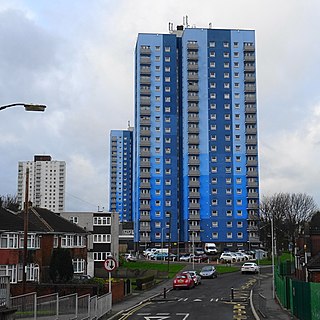
Wednesfield is a town and historic village in the City of Wolverhampton, West Midlands, England, It is 2 miles (3.2 km) east-northeast of Wolverhampton city centre, and is part of the West Midlands conurbation. It was historically within the county of Staffordshire.
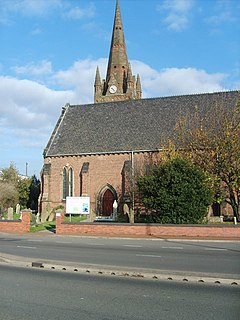
Moxley is a suburb of Darlaston in the Metropolitan Borough of Walsall, West Midlands County, England. It was first developed during the early part of the 19th century when a handful of terraced houses were built to accommodate locals working in factories and mines and the area was created in 1845 out of land from Darlaston, Bilston and Wednesbury.

Wolverhampton Art Gallery is located in the City of Wolverhampton, in the West Midlands, United Kingdom. The building was funded and constructed by local contractor Philip Horsman (1825–1890), and built on land provided by the municipal authority. It opened in May 1884.
Blakenhall is a suburb and ward in Wolverhampton, England.
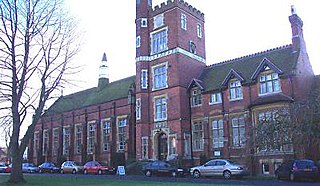
Wolverhampton Grammar School is a co-educational independent school in Wolverhampton, England.

Bantock House Museum and Park, is a museum of Edwardian life and local history, with 48 acres (190,000 m2) of surrounding parkland in Wolverhampton, England. It is named after Alderman Baldwin and Kitty Bantock who once lived there. It is run by Wolverhampton City Council's Arts and Museums service.

Wolverhampton is a city, metropolitan borough and administrative centre in the West Midlands, England. At the 2011 census, it had a population of 249,470. People from the city are called "Wulfrunians".
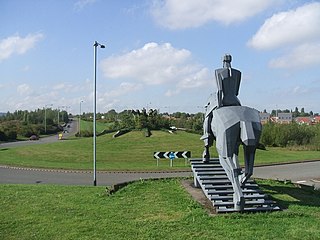
The Lunt is a residential area of Bilston within the city of Wolverhampton and is part of the West Midlands conurbation in England.

The Wolverhampton Grand Theatre, commonly known as The Grand, is a theatre located on Lichfield Street, Wolverhampton, UK, designed in 1894 by Architect Charles J. Phipps. It is a Grade II Listed Building with a seating capacity of 1200.
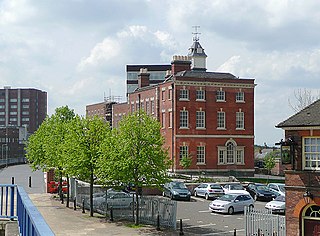
The Molineux Hotel in Wolverhampton is an 18th-century former mansion house known as Molineux House, which later served as a hotel and currently, following restoration serves as a local authority facility. It is a Grade II* listed building.
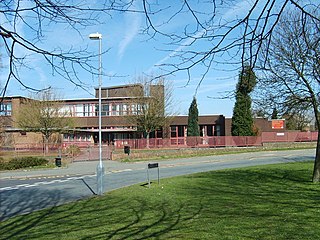
Moseley Park School is a mixed secondary school and sixth form located in the Bilston area of Wolverhampton, West Midlands, England.

Bilston Craft Gallery is the largest dedicated craft venue in the West Midlands, located at Mount Pleasant, Bilston, near Bilston town centre.

Wolverhampton Corporation Tramways operated a tramway service in Wolverhampton between 1902 and 1928.

Formerly called the People's Park, Wolverhampton's West Park was opened on 6 June 1881.

Sunbeamland is the name for a manufacturing complex close to the centre of Wolverhampton, near England's "Black Country". Sunbeamland is where John Marston, a design engineer and entrepreneur, developed several large clusters of factory buildings. The name "Sunbeamland" is derived from the Sunbeam range of motorcycles. A mile south of Sunbeamland, in Blakenhall, lies the Sunbeam Motor Car Company and Villiers Engineering, which became two of Wolverhampton's most important industries.



















